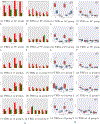Model-based image updating in deep brain stimulation with assimilation of deep brain sparse data
- PMID: 37418478
- PMCID: PMC12169340
- DOI: 10.1002/mp.16578
Model-based image updating in deep brain stimulation with assimilation of deep brain sparse data
Abstract
Background: Accuracy of electrode placement for deep brain stimulation (DBS) is critical to achieving desired surgical outcomes and impacts the efficacy of treating neurodegenerative diseases. Intraoperative brain shift degrades the accuracy of surgical navigation based on preoperative images.
Purpose: We extended a model-based image updating scheme to address intraoperative brain shift in DBS surgery and improved its accuracy in deep brain.
Methods: We evaluated 10 patients, retrospectively, who underwent bilateral DBS surgery and classified them into groups of large and small deformation based on a 2 mm subsurface movement threshold and brain shift index of 5%. In each case, sparse brain deformation data were used to estimate whole brain displacements and deform preoperative CT (preCT) to generate updated CT (uCT). Accuracy of uCT was assessed using target registration errors (TREs) at the Anterior Commissure (AC), Posterior Commissure (PC), and four calcification points in the sub-ventricular area by comparing their locations in uCT with their ground truth counterparts in postoperative CT (postCT).
Results: In the large deformation group, TREs were reduced from 2.5 mm in preCT to 1.2 mm in uCT (53% compensation); in the small deformation group, errors were reduced from 1.25 to 0.74 mm (41%). Average reduction of TREs at AC, PC and pineal gland were significant, statistically (p ⩽ 0.01).
Conclusions: With more rigorous validation of model results, this study confirms the feasibility of improving the accuracy of model-based image updating in compensating for intraoperative brain shift during DBS procedures by assimilating deep brain sparse data.
Keywords: biomechanical modeling; deep brain stimulation; image updating.
© 2023 American Association of Physicists in Medicine.
Figures











Similar articles
-
Model-Based Image Updating for Brain Shift in Deep Brain Stimulation Electrode Placement Surgery.IEEE Trans Biomed Eng. 2020 Dec;67(12):3542-3552. doi: 10.1109/TBME.2020.2990669. Epub 2020 Nov 19. IEEE Trans Biomed Eng. 2020. PMID: 32340934 Free PMC article.
-
Accounting for Deformation in Deep Brain Stimulation Surgery With Models: Comparison to Interventional Magnetic Resonance Imaging.IEEE Trans Biomed Eng. 2020 Oct;67(10):2934-2944. doi: 10.1109/TBME.2020.2974102. Epub 2020 Feb 14. IEEE Trans Biomed Eng. 2020. PMID: 32078527 Free PMC article.
-
Intraoperative image updating for brain shift following dural opening.J Neurosurg. 2017 Jun;126(6):1924-1933. doi: 10.3171/2016.6.JNS152953. Epub 2016 Sep 9. J Neurosurg. 2017. PMID: 27611206 Free PMC article.
-
IBIS: an OR ready open-source platform for image-guided neurosurgery.Int J Comput Assist Radiol Surg. 2017 Mar;12(3):363-378. doi: 10.1007/s11548-016-1478-0. Epub 2016 Aug 31. Int J Comput Assist Radiol Surg. 2017. PMID: 27581336 Review.
-
Review on Factors Affecting Targeting Accuracy of Deep Brain Stimulation Electrode Implantation between 2001 and 2015.Stereotact Funct Neurosurg. 2016;94(6):351-362. doi: 10.1159/000449206. Epub 2016 Oct 27. Stereotact Funct Neurosurg. 2016. PMID: 27784015 Review.
References
-
- Holl EM, Petersen EA, Foltynie T, Martinez-Torres I, Limousin P, Hariz MI, and Zrinzo L, Improving Targeting in Image-Guided Frame-Based Deep Brain Stimulation, Operative Neurosurgery 67, ons437–ons447 (2010). - PubMed
-
- Richardson RM, Ostrem JL, and Starr PA, Surgical Repositioning of Misplaced Subthalamic Electrodes in Parkinson’s Disease: Location of Effective and Ineffective Leads, Stereotactic and Functional Neurosurgery 87, 297–303 (2009). - PubMed
-
- Papavassiliou E, Rau G, Heath S, Abosch A, Barbaro NM, Larson PS, Lam-born K, and Starr PA, Thalamic Deep Brain Stimulation for Essential Tremor: Relation of Lead Location to Outcome, Neurosurgery 54, 1120–1130 (2004). - PubMed
-
- Ivan ME, Yarlagadda J, Saxena AP, Martin AJ, Starr PA, Sootsman WK, and Larson PS, Brain Shift during Bur Hole-Based Procedures Using Interventional MRI, Journal of Neurosurgery 121, 149–160 (2014). - PubMed
-
- Khan MF, Mewes K, Gross RE, and Škrinjar O, Assessment of Brain Shift Related to Deep Brain Stimulation Surgery, Stereotactic and Functional Neurosurgery 86, 44–53 (2008). - PubMed
MeSH terms
Grants and funding
LinkOut - more resources
Full Text Sources

